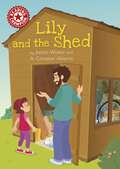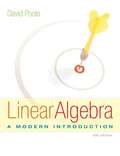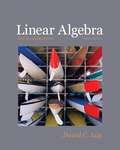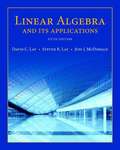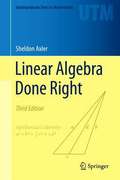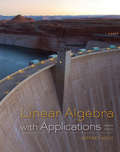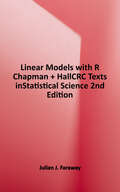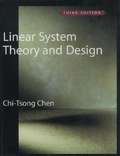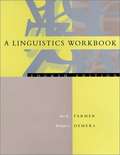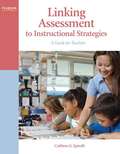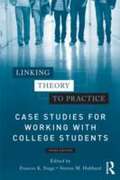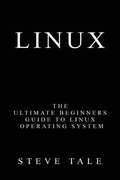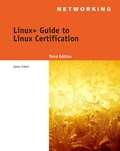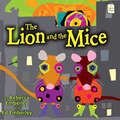- Table View
- List View
Lily and the Shed: Independent Reading Red 2 (Reading Champion #516)
by Jackie WalterThis story is part of Reading Champion, a series carefully linked to book bands to encourage independent reading skills, developed with Dr Sue Bodman and Glen Franklin of UCL Institute of Education (IOE)Lily and the Shed shows a girl determined to make the perfect den in an old shed - and with some hard work, she gets it just right!Reading Champion offers independent reading books for children to practise and reinforce their developing reading skills.Fantastic, original stories are accompanied by engaging artwork and a reading activity. Each book has been carefully graded so that it can be matched to a child's reading ability, encouraging reading for pleasure. Perfect for 4-5 year olds or those reading book band red 2.
Lily y su bolso de plástico morado (¡Arriba la Lectura!, Trade Book #11)
by Kevin HenkesNIMAC-sourced textbook
Lily's Amazing Hair (Fountas & Pinnell Classroom, Guided Reading Grade 3)
by Leslie Budnick Jimmy HolderNIMAC-sourced textbook
Lily's Grouchy Day (Fountas & Pinnell Classroom, Guided Reading Grade 3)
by Leslie Budnick Jimmy HolderNIMAC-sourced textbook
Lily's New Game (Fountas & Pinnell Classroom, Guided Reading Grade 3)
by Leslie Budnick Jimmy HolderNIMAC-sourced textbook
Lincoln-Douglas Debate: Values in Conflict (2nd edition)
by Jeffrey Wiese Stan LewisThis book examines the history and nature of Lincoln-Douglas debate in society and introduces value debate by comparing and contrasting it with policy debate.
Line in the Sand: Preserving Bedouin Culture (Fountas & Pinnell Classroom, Guided Reading Grade 6)
by Amanda YskampNIMAC-sourced textbook
Linear Algebra
by Paul DawkinsFrom the author: Here are my online notes for my Linear Algebra course that I teach here at Lamar University. Despite the fact that these are my "class notes", they should be accessible to anyone wanting to learn Linear Algebra or needing a refresher. These notes do assume that the reader has a good working knowledge of basic Algebra. This set of notes is fairly self contained but there is enough Algebra type problems (arithmetic and occasionally solving equations) that can show up that not having a good background in Algebra can cause the occasional problem.
Linear Algebra: A Modern Introduction
by David PooleThis fourth edition emphasizes a vectors approach and better prepares students to make the transition from computational to theoretical mathematics. Balancing theory and applications, the book is written in a conversational style and combines a traditional presentation with a focus on student-centered learning. Theoretical, computational, and applied topics are presented in a flexible yet integrated way. Stressing geometric understanding before computational techniques, vectors and vector geometry are introduced early to help students visualize concepts and develop mathematical maturity for abstract thinking. Additionally, the book includes ample applications drawn from a variety of disciplines, which reinforce the fact that linear algebra is a valuable tool for modeling real-life problems.
Linear Algebra and Its Applications, 4th Edition
by David C. LayThis Fourth Edition provides a modern elementary introduction to linear algebra and a broad selection of interesting applications.
Linear Algebra and Its Applications, Fifth Edition
by David C. Lay Steven R. Lay Judi J. McdonaldWith traditional linear algebra texts, the course is relatively easy for students during the early stages as material is presented in a familiar, concrete setting. However, when abstract concepts are introduced, students often hit a wall. Instructors seem to agree that certain concepts (such as linear independence, spanning, subspace, vector space, and linear transformations) are not easily understood and require time to assimilate. These concepts are fundamental to the study of linear algebra, so students' understanding of them is vital to mastering the subject. This text makes these concepts more accessible by introducing them early in a familiar, concrete Rn setting, developing them gradually, and returning to them throughout the text so that when they are discussed in the abstract, students are readily able to understand.
Linear Algebra Done Right
by Sheldon AxlerThis best-selling textbook for a second course in linear algebra is aimed at undergrad math majors and graduate students. The novel approach taken here banishes determinants to the end of the book. The text focuses on the central goal of linear algebra: understanding the structure of linear operators on finite-dimensional vector spaces. The author has taken unusual care to motivate concepts and to simplify proofs. A variety of interesting exercises in each chapter helps students understand and manipulate the objects of linear algebra. <p><p> The third edition contains major improvements and revisions throughout the book. More than 300 new exercises have been added since the previous edition. Many new examples have been added to illustrate the key ideas of linear algebra. New topics covered in the book include product spaces, quotient spaces, and dual spaces. Beautiful new formatting creates pages with an unusually pleasant appearance in both print and electronic versions. <p> No prerequisites are assumed other than the usual demand for suitable mathematical maturity. Thus the text starts by discussing vector spaces, linear independence, span, basis, and dimension. The book then deals with linear maps, eigenvalues, and eigenvectors. Inner-product spaces are introduced, leading to the finite-dimensional spectral theorem and its consequences. Generalized eigenvectors are then used to provide insight into the structure of a linear operator.
Linear Algebra with Applications (Second Edition)
by Jeffrey HoltHolt's Linear Algebra with Applications, Second Edition, blends computational and conceptual topics throughout to prepare students for the rigors of conceptual thinking in an abstract setting. The early treatment of conceptual topics in the context of Euclidean space gives students more time, and a familiar setting, in which to absorb them. This organization also makes it possible to treat eigenvalues and eigenvectors earlier than in most texts. Abstract vector spaces are introduced later, once students have developed a solid conceptual foundation. <p><p> Concepts and topics are frequently accompanied by applications to provide context and motivation. Because many students learn by example, Linear Algebra with Applications provides a large number of representative examples, over and above those used to introduce topics. The text also has over 2500 exercises, covering computational and conceptual topics over a range of difficulty levels.
Linear Models with R (Chapman & Hall/CRC Texts in Statistical Science)
by Julian J. FarawayA Hands-On Way to Learning Data Analysis <p><p> Part of the core of statistics, linear models are used to make predictions and explain the relationship between the response and the predictors. Understanding linear models is crucial to a broader competence in the practice of statistics. Linear Models with R, Second Edition explains how to use linear models in physical science, engineering, social science, and business applications. The book incorporates several improvements that reflect how the world of R has greatly expanded since the publication of the first edition. <p><p> New to the Second Edition <p><p> <p>•Reorganized material on interpreting linear models, which distinguishes the main applications of prediction and explanation and introduces elementary notions of causality <p>•Additional topics, including QR decomposition, splines, additive models, Lasso, multiple imputation, and false discovery rates <p>•Extensive use of the ggplot2 graphics package in addition to base graphics <p><p>Like its widely praised, best-selling predecessor, this edition combines statistics and R to seamlessly give a coherent exposition of the practice of linear modeling. The text offers up-to-date insight on essential data analysis topics, from estimation, inference, and prediction to missing data, factorial models, and block designs. Numerous examples illustrate how to apply the different methods using R.
Linear System Theory and Design
by Chi-Tsong ChenAn extensive revision of the author's highly successful text, this third edition of Linear System Theory and Design has been made more accessible to students from all related backgrounds. After introducing the fundamental properties of linear systems, the text discusses design using state equations and transfer functions. In state-space design, Lyapunov equations are used extensively to design state feedback and state estimators. In the discussion of transfer-function design, pole placement, model matching, and their applications in tracking and disturbance rejection are covered. Both one-and two-degree-of-freedom configurations are used. All designs can be accomplished by solving sets of linear algebraic equations. <p><p> All results in this new edition are developed for numerical computation and illustrated using MATLAB, with an emphasis on the ideas behind the computation and interpretation of results. This book develops all theorems and results in a logical way so that readers can gain an intuitive understanding of the theorems. This revised edition begins with the time-invariant case and extends through the time-varying case. It also starts with single-input single-output design and extends to multi-input multi-output design. Striking a balance between theory and applications, Linear System Theory and Design, 3/e, is ideal for use in advanced undergraduate/first-year graduate courses in linear systems and multivariable system design in electrical, mechanical, chemical, and aeronautical engineering departments. It assumes a working knowledge of linear algebra and the Laplace transform and an elementary knowledge of differential equations.
Linguistic Fieldwork: A Student Guide
by Jeanette Sakel Daniel L. EverettA handy beginner's guide, this textbook introduces the various stages of linguistic fieldwork, from the preparation of the work to the presentation of the results. Drawing on over forty years of fieldwork experience between them, in over two dozen languages, the authors pack the book with examples and anecdotes from their experiences and include practical exercises for students to test what they have learned. Independent of any particular perspective, the methods can be applied to a wide range of fieldwork settings, for projects with very different theoretical backgrounds and without the need to travel too far. The book covers 'traditional fieldwork' such as language description and documentation, as well as less typical methods, including language contact and quantitative studies with experiments or questionnaires.
Linguistics for Educators: A Practical Guide Second Edition with Exercises
by Steven Landon WestA practical guide for Linguistics for Educators
A Linguistics Workbook (4th edition)
by Ann K. FarmerIt is extremely important that students become familiar with the structural properties of languages other than English. In A Linguistics Workbook, therefore, we have provided exercises based on a wide variety of the world's languages.
Linking Assessment to Instructional Strategies: A Guide for Teachers
by Cathleen SpinelliThis practical, teacher-friendly book provides step-by-step instructions on choosing and administering classroom assessments; analyzing, interpreting, rating, and monitoring results; and reporting student progress. Whether new to authentic or informal assessment, or strongly familiar with traditional testing, this book will interpret and guide the teaching professional on how to integrate cutting-edge assessment measures seamlessly into their daily teaching schedule. The book is chock-full of the latest in authentic, curriculum and performance-based assessment measures with direct connections to instruction, IEP development, and methods of reporting to parents. Busy teachers will appreciate the clear, accessible writing style and how easily the book helps them to determine what test to use, the specific diagnostic questions to ask, the classroom materials that will be needed, clearly informed administration strategies, and the explicit examples that are included and can be taken straight from the page to the real classroom. Keenly focused on providing teachers with a variety of assessment procedures, including the why, what, and how of testing, it furthermore gives directions on how to construct, administer, and score assessments as well as how to interpret, graph, monitor, write, and report assessment results to families and school support personnel. Another key feature includes suggested interventions to use when test results indicate that specific skills have been mastered, are emerging, or need to be introduced. An ideal book for school administrators, supervisors, and remedial specialists, and for those implementing Response to Intervention (RI), it is most appropriate for professional development and in-service practicing teachers who want an easy-to-read and useful guide to state-of-the-art, best practices in assessment.
Linking Theory to Practice: Case Studies For Working With College Students (Third Edition)
by Frances K. Stage Steven M. HubbardFramed by an overview of theories that guide student affairs practice, the cases in this book present a challenging array of problems that student affairs and higher education personnel face, such as racial diversity, alcohol abuse, and student activism. The revised edition has thirty new cases, with content on issues that reflect the complexity of today's environment at colleges and universities, including the expanded use of social networking, the rise in mental health issues, bullying, study abroad, and athletics. The fully updated edition includes new references, expanded theory with an increased emphasis on race, ethnicity, and sexual orientation, and three entirely new chapters on admissions, student identity, and campus life. An excellent teaching tool, this book challenges students to consider multiple overlapping issues within a single case study. Features include: A two-part structure that sets the stage for case study methods and links student affairs theory with practical applications Cases written by well-known and respected contributors set in a wide variety of institution types and locations Over 35 complex case studies reflecting the multifaceted issues student affairs professionals face in today's college environment.
Linux: The Ultimate Beginners Guide To Linux Operating System
by Steve TaleLinux: The Ultimate Beginners Guide to Linux Operating System is a quick-reference guide that will walk you through installation, configuration, and usage of the Linux OS. If you are new to this operating system, this book will allow you to get complete instructions on how you can quickly use Linux on your computer, learn how to operate programs and browse the internet, and use shortcuts that will allow you to navigate through the operating system with ease. This book is designed in such a way that you do not have to read all the chapters subsequently – you can jump from one chapter or section to another, depending on what topic you need to look up.
Linux+ Guide To Linux Certification (Third Edition)
by Jason W. EckertLINUX+ GUIDE TO LINUX CERTIFICATION, THIRD EDITION offers the most up-to-date information to empower users to successfully pass CompTIA's Linux+ (Powered by LPI) Certification exam, while maintaining a focus on quality, classroom usability, and real-world experience. This complete guide provides not only the conceptual knowledge, but also the hands-on skills necessary to work with the Linux operation systems in a network administration environment. Comprehensive coverage includes updated information pertinent to the latest Linux distributions, as well as new storage technologies such as LVM and ext4. Readers will learn about new and expanded material on key job-related networking services including FTP, NFS, Samba, Apache, DNS, DHCP, NTP, RADIUS, LDAP, Squid, Sendmail, Postfix, X, SSH, VNC, SQL, and updated information on security practices and technologies. The Hands-On Projects help learners practice new skills, and review questions and key terms reinforce important concepts.
The Lion and the Mice
by Rebecca EmberleyIn this color-drenched interpretation of Aesop's fable, a mouse, in colorful attire suitable for a night on the town, finds herself trapped by a caged lion in the city zoo. The mouse begs to be released and promises to help the lion one day. The lion is skeptical but releases her nonetheless. Later that night, the mouse returns with mouse friends—as spiffily attired as she herself—and together they unlock the lion's cage and prove that "little mice can be big friends." An I Like to Read® book. Guided Reading Level E.

